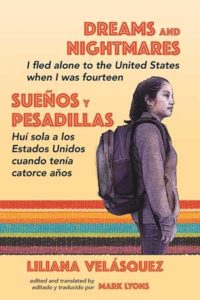Dreams and Nightmares
Reviewed by Ken Jacobsen
December 1, 2017
 I Fled Alone to the United States When I Was Fourteen / Sueños y pesadillas: Huí sola a los Estados Unidos cuando tenía catorce años
I Fled Alone to the United States When I Was Fourteen / Sueños y pesadillas: Huí sola a los Estados Unidos cuando tenía catorce años
By Liliana Velásquez, edited and translated by Mark Lyons. Parlor Press, 2017. 212 pages. $22.95/paperback. Recommended for young adults.
Young Liliana Velásquez has a story to tell, and after a years-long odyssey from her village in Guatemala to her foster family in Philadelphia, Pa., she has the opportunity to tell it in this richly detailed bilingual book, which includes her Spanish words on the left of each page and the fine English translation on the right. Her storytelling mentor and translator, Mark Lyons, has coaxed forth not only Liliana’s narrative, but its significance for all of us Americans in this “nation of immigrants.” If we search our family histories, as this book encourages us to do, many of us will find forebears pulled to this land and pushed from their own by “dreams and nightmares” akin to Liliana’s. Her book poses the timely questions in this era of often divisive debate about immigration to the United States. Shall we continue to be a nation of immigrants, welcoming the dreamers of the world and their ever-renewing dreams or shall we wall ourselves off from them?
Teenage readers from middle school to high school will identify with Liliana’s odyssey, which begins with her as a 14-year-old girl fleeing alone the violence, abuse, and poverty of her Guatemalan family and village, then turns to her often dangerous trek by foot, freight train, and bus across Mexico, with an assortment of kind and unkind fellow travelers, authorities, and “coyotes” (cross-border guides) along the way. When she is captured by ICE (Immigration and Customs Enforcement) agents in Arizona, she fears her dreams of a new life are over. But compassionate counselors and social workers in the ICE system manage to find a new home for her in Philadelphia with two foster families (the first family a harsh experience, the second a wonderful one). Here Liliana is able to get the education she never had, learning English and a vocation, and with a green card she is able to work and send money to her birth family in Guatemala, fulfilling a promise she had made to herself. Liliana’s is the story of a young person with the courage to seek a better life away from crisis, and it is also the story of a young woman—who was told growing up that women have no value—deciding that women, like men, do indeed have value and deserve a life of dignity and opportunity.
While Liliana’s story will speak to her teenage peers, it will also speak to adults who seek to understand and empathize with the immigrants of our time, who will risk everything to reach our land of opportunity. Liliana gives a needed voice and face to the national discourse on immigration—in many ways, we discover Liliana is one of us.
Dreams and Nightmares / Sueños y pesadillas comes with an excellent teacher’s guide, which uses the book as a springboard for a teaching unit on America and its immigrants, past and present. The guide leads students into deeper reflection on Liliana’s story while encouraging them to explore their own families, conducting oral histories with elder members who were immigrants themselves or who recall immigrant stories of ancestors. Of the two films named as learning resources in the guide, I recommend El Norte (The North), a brother-and-sister journey from Central America to Los Angeles that resonates with and expands on themes in Liliana’s story. However, I would be cautious about using the second film, Sin Nombre (Without a Name), with students. It is so graphically focused on the violence of the Mexican gang the protagonist is seeking to escape that the film’s deeper human themes of immigration, dreams for a better life, and the saving kindness of others along the way are almost lost.
Finally, a note to Spanish and bilingual teachers: written in simple and accessible Spanish with English translation alongside, Dreams and Nightmares / Sueños y pesadillas, a compelling and real-life adventure, can be an effective teaching tool for English speakers to learn Spanish and vice versa. There are indeed many gifts in this book, which is a collaborative labor of love between Liliana Velásquez and her mentor Mark Lyons.



Comments on Friendsjournal.org may be used in the Forum of the print magazine and may be edited for length and clarity.